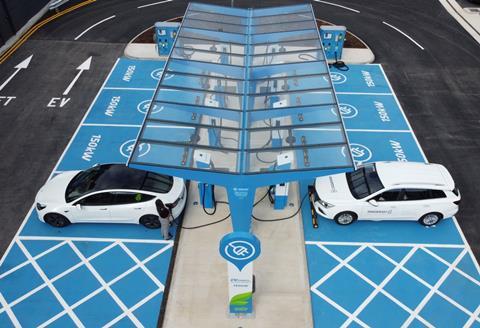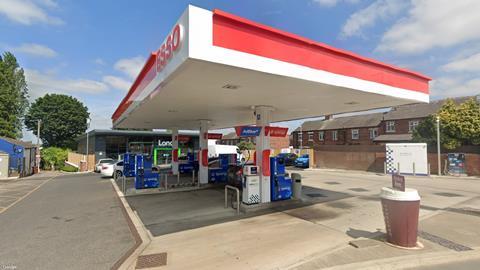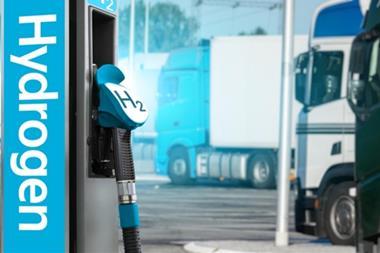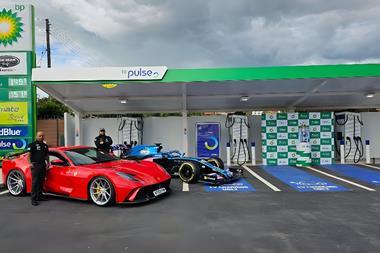
The race to provide EV charging across the UK continues with BT the latest to sign up. The communications giant’s start-up and digital incubation team, Etc., is conducting trials to turn BT’s street cabinets into EV charging units.
The green cabinets – familiar on streets up and down the country – are currently used to provide copper-based broadband and phone services. However, they are being decommissioned as the upgrade to full fibre connections continues.
The first phase of BT’s EV charging pilot scheme will kick off in Northern Ireland in the autumn with other UK locations following. Etc.’s early projections reveal that possibly 60,000 of BT’s 90,000 green cabinets may be suitable for the trials.
BT’s efforts follow headlines that the government is way behind in its ambition to provide 300,000 charge points by 2030. Media reports estimate that the government is as much as 20 years behind schedule.
Zap Map figures to the end of June 2023, reveal that there are 44,408 EV charging points across the UK, across 25,521 locations. This represents a 36% increase in the total number of charging devices since June 2022. It all sounds great but it would require a massive jump in installations to reach that 300,000 charge point target.
Across the forecourt sector, there has been varying responses to embracing the EV revolution. Of course, retailers know change is inevitable but whether that change can happen on their sites now is another story. It all comes down to money, space and the ability to get the electricity supply needed to charge those cars.

Top 50 Indie MFG has been very bold in its plans for EV charging but speaking earlier this year at the Forecourt Trader Summit 2023, chief executive William Bannister said getting the infrastructure in place was a time-consuming business. He also alluded to MFG’s deep pockets saying investment in EV charging was done out of ‘free cash’ which means the company could go as fast or as slow as the market demanded and that they were not expecting a return on the investment straight away.
There’s no doubting that getting EV charging installed on a forecourt site can be tricky as independent retailer Roger Perry, who has two sites in West Yorkshire, can attest.
Roger started on plans to build a new shop at Prospect Service Station in Ossett back in early 2021 – and install EV charge points at the same time. He takes up the story: “As the direction of travel was EV charging and, bearing in mind the proximity to the M1 motorway, I wanted to include an ultra-rapid charger if possible. I felt this would help future-proof the site. But it has taken so long to bring it to fruition; gaining planning permission took 12 months and there were problems getting a meter installed.
“I paid for the installation outright and used a firm local to my other site at Leven, Energyforce, to do the work. It was relatively easy to get the quotes for equipment, grid connection and the necessary civil work. The time consuming and frustrating bit was getting a supply agreement, a meter point reference and the meter installed.”
Roger admits he was not sure as to the viability of a charger and that the cost of getting the charger installed was in the region of £100k.
“I felt this was a worthwhile gamble based on how I saw things at the time. Back in 2021, my fairly conservative projections looked like giving me a return in five to seven years.
“There are three chargers currently around Ossett, however they are all rated at 50-75kW. My thinking was that, taking into account customer expectations and the space constraints that most forecourts have, high-powered chargers rated 150kW and above are really the only ones that are suitable.”
But a lot has changed since 2021. “We started investing in this project back in 2021 before the Russian invasion of Ukraine and the hike in energy prices. There was sufficient capacity in the area for a 275KVA supply and no more. I agreed to pay for this back in autumn 2021 to secure the supply. We had a very reasonable quote from Northern Power Grid to get the cabling to the site (about 300m) and in order to fix the price I had to pay up front before the energy crisis hit. So when the prices spiked the bulk of the investment had been made.
“Our projections were done on electricity at around 16p per kW and selling out at 35-40p. We are now in the situation where cost is around the 30p mark. I am not at all sure what the demand will now be. As I understand it, as a result of the cost of electricity, demand for electric cars has started to stall. On top of this, the way fixed charges for electricity are now calculated, we are now facing a fixed standing charge of £37 per day for the power supply for the charger. This all means we are going to have to charge 60/70p per kW to the customer.”

Needless to say all these things have made Roger a little pessimistic about the viability of the whole project. “I see the cost as being prohibitive at the moment for small/medium independents to enter the EV charging market.
“EVs are something the government is keen to promote so I really think they need to have a good hard look at the barriers to entry if they want ultra-rapid EV charging to become a widespread reality. Given what I know now I would not have decided to proceed with this project. Having said that, we will make the best of the opportunity this presents and see where it takes us. As the costs are so high, this will no doubt limit other competitors coming into the market, which can only work to our advantage. I think that I have made this investment four to five years too soon. There is however the capacity issue to consider, I have now secured the only spare capacity in the area and this has given us the ability, with battery back-up, to run three 150kW chargers should the demand be there. Time will tell how far away the demand for this level of EV charging is.”
Roger’s is a sobering tale but one that is likely repeated across the UK.

Cleaner power
Jennifer Smith, smart EV charging solutions lead at Schneider Electric, says the lack of grid infrastructure is the single biggest blocker to deployment of new low carbon power in the UK.
“A number of renewable and clean energy projects have been delayed from connecting to the grid, creating a queue in the process. This is being addressed, but the UK needs to get these projects connected as quickly as possible to help drive green investment and lower emissions. The government has targeted the rollout of 300,000 EV charging stations across the UK by the end of the decade, but despite a 36% increase in the last 12 months the reality is that currently, there aren’t enough public charging hubs available to meet demand.
“We need to install EV chargers in vast quantities nationwide. This includes residential buildings and office campuses, but predominantly at en route locations like petrol forecourts and motorway services. A typical building requires up to 40% more energy to support an EV charging installation and larger scale hubs have more complex capacity requirements. Unfortunately, many were built over 30-40 years ago and weren’t wired up to cater for the Tesla Model 3 or the Nissan Leaf. So, we’re looking at a capacity issue that needs to be addressed urgently to accommodate more EV charging installations.”
Smith advises that petrol forecourts, motorway services and other en route locations install solutions that optimise the existing capacity and facilitate a switch to cleaner energy based on renewables and microgrids further down the line.
“These solutions consist of equipment that enables electrical power distribution and digital tools that monitor and regulate power usage, capacity and storage. It will allow en route locations to manage their power consumption more effectively, lower emissions and monetise EV charging assets. This type of infrastructure is necessary to provide electric charging points and expand EV charging hubs across the UK. The software also supports asset tracking and availability to monitor the performance of EV chargers, identify faults and even repair them remotely, helping to improve the EV charging experience for customers.”
Smith is adamant that from an EV charging perspective, the solution doesn’t simply lie in adding capacity. “It’s about using clean power sources and having a clear energy strategy, which involves getting guidance on planning, designing, implementing, operating, and maintaining the infrastructure to ensure optimum use of the existing capacity. Then you can begin to gradually integrate renewables and clean energy supplies into the mix.”


























